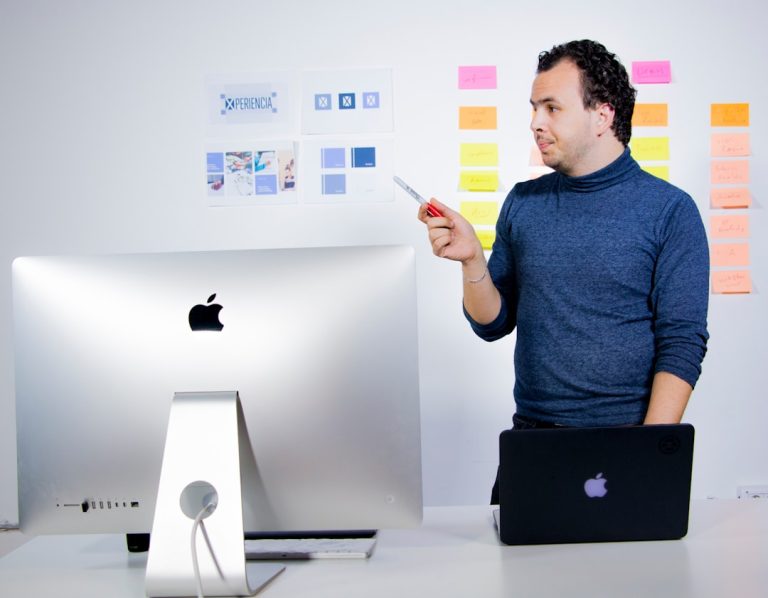Engaging Students with Technology: 5 Lesson Plan Ideas for a Tech-Savvy Classroom
In the current digital era, technology has assimilated into our everyday existence. It has transformed a number of sectors, including education. The way teachers and students learn has changed as a result of the widespread use of technology in the classroom. For both teachers and students, it has created new avenues for exploration.
Key Takeaways
- Technology plays a crucial role in modern education
- Tech-savvy classrooms offer numerous benefits to both teachers and students
- Interactive learning with digital whiteboards can enhance student engagement
- Collaborative learning with Google Docs promotes teamwork and communication skills
- Gamification of learning with educational apps can make lessons more fun and engaging
Technology in the classroom offers a wealth of advantages. It raises student motivation and engagement levels, individualizes instruction for each student, and fosters better student cooperation and communication. Through the integration of technology into their lesson plans, educators can establish a technologically-savvy classroom that stimulates creativity, critical thinking, & problem-solving abilities. A. Boosting Student Motivation & Engagement: Increasing student motivation and engagement is one of the main advantages of implementing technology in the classroom.
The inability of traditional teaching methods to hold students’ attention frequently results in their disengagement & lack of participation. But students’ attention is piqued by the immersive, interactive learning experiences that technology offers. One way to make lessons more interactive is by using digital whiteboards. Instructors can add audio, visuals, and videos to their lessons to make them more interesting.
By working together with their peers, solving puzzles, and interacting with the digital whiteboard, students can actively participate. C. Customizing Education for Students: One more benefit of a technologically advanced classroom is the capacity to tailor instruction to each student. Every learner has different requirements and preferences. By adjusting their lessons to each student’s unique needs, teachers can use technology to make sure they are getting the help and direction they need.
| Lesson Plan | Objective | Technology Used | Engagement Level |
|---|---|---|---|
| Virtual Field Trip | To explore a new location and learn about its history and culture | Google Earth, Virtual Reality Headsets | High |
| Interactive Presentations | To create engaging and interactive presentations to share knowledge | Prezi, Powtoon, Google Slides | Medium |
| Collaborative Writing | To work together on a writing project and learn from each other | Google Docs, Microsoft Word Online | High |
| Game-Based Learning | To learn through playing educational games | Kahoot, Quizlet, Minecraft | High |
| Virtual Science Lab | To conduct experiments and learn about science in a virtual environment | Labster, PhET Interactive Simulations | High |
One tool for promoting collaborative learning is Google Docs. Students can collaborate on a document while exchanging real-time comments & ideas. This not only promotes involvement but also enables educators to track & evaluate each student’s development. C. Enhancing Student Collaboration & Communication: Technology is an essential factor in enhancing student collaboration and communication.
In a conventional classroom, students are frequently working alone or in small groups. Nonetheless, students can work together on assignments & projects using technology, regardless of where they are physically located. Apps for education are a fantastic resource for encouraging teamwork. On a virtual platform, students can collaborate while exchanging resources and ideas.
This encourages cooperation & communication, two things that are necessary for success in the modern world. 1. Describe the Uses of Digital Whiteboards: Digital whiteboards are a great tool for interactive lesson creation. They make it possible for educators to convey knowledge in an interesting & lively way.
To make lessons more interactive, teachers can use a variety of features like touchscreens, digital pens, & multimedia components. 3. Offering Activities as Examples: Digital whiteboards can be used for a wide range of activities. Teachers can design interactive tests, for instance, in which students can touch the screen to respond to questions. Also, they can annotate diagrams & solve math problems using the digital pen. Video & image integration are further tools that educators can use to improve student learning.
D. Talking About the Advantages: Using digital whiteboards in the classroom has many advantages. They encourage participation and engagement with the material being covered in class, which fosters active learning. Also, they give students quick feedback so they can fix their errors and grow from them.
Digital whiteboards also improve visual and spatial learning, which helps students comprehend difficult ideas. A. Describe How to Use Google Docs: Google Docs is an excellent tool for promoting group education. Students can collaborate on a document using this tool, editing and revising it in real time. Instructors can design tasks and assignments that call for good teamwork and communication among the students. A.
Providing Activities as Examples: Google Docs can be used for a variety of activities. Teachers may give their students group projects, such as writing reports or creating presentations, where they must collaborate to complete. In order to encourage critical thinking and constructive criticism, students can also give each other peer feedback on their work. B. Talking About the Advantages: There are a lot of advantages to utilizing Google Docs in the classroom.
It encourages cooperation and teamwork since it allows students to collaborate on a document together no matter where they are physically located. Since students can view the contributions of their peers in real-time, it also promotes engagement & active participation. Also, Google Docs gives educators the ability to track and evaluate each student’s progress while promptly offering assistance and feedback. A.
Describe the Uses of Educational Apps: Educational apps are a fantastic way to make learning more interactive. They offer immersive, interactive experiences that add excitement and interest to learning. To further practice, assess understanding, and reinforce concepts, teachers can integrate educational apps into their lesson plans. B. Giving Examples of Educational Apps: Educational apps come in a lot and can be used in both classroom and educational settings.
One language learning app that employs gamification to teach foreign languages is called Duolingo. With the help of the app Kahoot, educators can make interactive tests & games. Creative thinking and problem-solving abilities are encouraged in the sandbox game Minecraft Education Edition. D.
Examining the Advantages:~
There are several advantages to utilizing educational applications in the classroom. Since they provide rewards for students’ accomplishments, they make learning engaging and inspiring. Also, they give students rapid feedback so they can grow in understanding and learn from their errors. In addition, educational applications accommodate various learning preferences and styles, guaranteeing that all students can take advantage of them.
A. How to Use PowerPoint: PowerPoint is a flexible tool that can be used to create multimedia presentations. It enables educators to deliver content in an orderly and aesthetically pleasing way. Teachers can improve the learning process by incorporating different multimedia elements, like audio, video, & images. 3.
Giving Examples of Activities: PowerPoint can be used for a wide range of activities. For example, educators can design interactive tests in which pupils must select the appropriate response to questions. To add interest to the presentations, they can also incorporate animations & transitions.
Teachers can also give students study guides or guided notes to refer to after the presentation. D. Talking About the AdvantagesUsing PowerPoint in the classroom has a lot of advantages.
It improves learning through both visual & auditory means, simplifying difficult concepts. Because students can respond to questions & participate in discussions, it also encourages active learning. Educators can also arrange & display data in a logical and structured way with PowerPoint.
A. What Google Earth Can Be Used For: Virtual field trips can be made with great success using Google Earth. It enables educators to visit various sites and landmarks across the globe without having to step outside of the classroom.
An immersive & interactive learning environment can be offered to students by teachers through the creation of virtual tours and activities. B. Giving Examples of Virtual Field Trips: Google Earth allows for the creation of many different types of virtual field trips. Instructors can, for instance, give their students a tour of China’s Great Wall & discuss its significance and history.
In addition, they can go to the Amazon Rainforest and discover more about its biodiversity and preservation initiatives. Teacher exploration options also include visiting well-known sites like the Taj Mahal and the Eiffel Tower. B.
Talking About the Benefits: Using Google Earth in the classroom has a lot of advantages. It gives students a global perspective and lets them investigate various environments and cultures. Because students can explore and engage with the virtual environment, it also improves their spatial awareness and geographic knowledge. Also, because Google Earth allows students to research & ask questions about the places they visit, it supports inquiry-based learning.
For educators, incorporating technology into lesson plans can be a difficult undertaking. But it can be a fulfilling and enriching experience if you prepare and plan ahead. Teachers can use the following advice to incorporate technology into their lesson plans:1. Prior to integrating technology into your lesson plans, clearly define the learning goals you hope to accomplish.
This will assist you in selecting technology-related tools and activities that support your objectives. 2. If you’re new to using technology in the classroom, start small by utilizing basic resources & exercises. As you gain comfort and confidence, gradually introduce increasingly complex tools and activities. 3. Offer guidance & assistance: Make certain that educators and learners alike obtain adequate guidance & assistance when utilizing digital resources.
Workshops, tutorials, and internet resources can all help with this. To share best practices & experiences, teachers should be encouraged to collaborate and learn from one another. 4. Employ a range of tech resources: Investigate various tech resources and platforms to accommodate varying learning inclinations & styles.
This will guarantee that the technology integration is beneficial to every student. 5. Assess & evaluate: Continually review and assess how well your lesson plans incorporate technology. Get student feedback and make the required changes to enhance the educational process. Teachers may encounter certain difficulties even with the many advantages of integrating technology into the classroom.
The following list of typical problems and solutions is provided: 1. Technical problems: Software bugs or issues with internet connectivity can cause havoc with learning. If there are any technical issues, make sure you have a fallback plan. Examine the technological resources & platforms prior to the class to find any possible problems. 2.
Insufficient resources: Some educational institutions do not possess the newest technological tools and resources. Nevertheless, there are frequently substitute choices available. Examine inexpensive or free digital resources and resources that can improve education. 3. Opposition to change: Some educators or students might be reluctant to adopt new technologies in the classroom.
Give concise justifications of the advantages and benefits of utilizing technology. To allay any worries or misunderstandings, promote candid dialogue. 4. Technology can be a double-edged sword in that it can be a source of misuse and distractions. Provide precise instructions and standards for the use of technology in the classroom.
In order to guarantee that technology is used properly and efficiently, keep an eye on & enforce these rules. To conclude, in the current digital era, the integration of technology into education has gained significant importance. It increases student motivation and engagement, student-centered learning, and student cooperation & communication. Teachers can build a tech-savvy classroom that encourages creativity, critical thinking, and problem-solving abilities by integrating technology into their lesson plans.
Continuous exploration and adoption of new technological applications in the classroom is imperative for educators. By doing this, they can provide their students with the information & abilities they need to prosper in the contemporary world. Technology is a potent tool that can improve and enrich the learning process rather than taking the place of conventional teaching techniques. In order to give our students a better future, let’s embrace technology.
Escape Rooms are interactive activities that combines technology skills with problem-solving and critical thinking, making them an exciting and educational experience for students. Check out the article here to learn more about how you can incorporate this fun and challenging escape room into your lesson plans. And while you’re at it, don’t forget to explore other helpful resources like “101 Photoshop Tips” here and a guide on how to blur backgrounds in Photoshop here.




